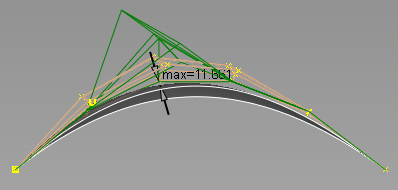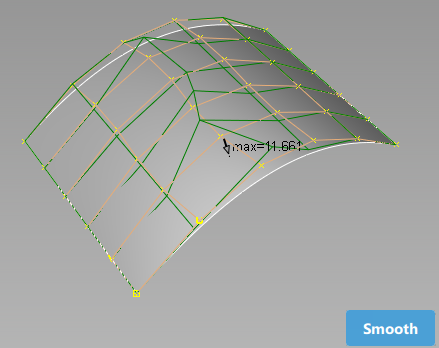 Smooth
Smooth
Improves the smoothness of surfaces and curves by harmonizing CV distances and simultaneously minimizing angles/kinks inside the hulls.
Access this tool from the Object Edit tool palette:

Smooth Options
Smoothing Factor
Controls the effect of each smoothing step. The smaller the smoothing factor, the smaller the movements of the CVs.
Undo
Interpolates between the current result and the original input. A value of 1 shows the final result of all smoothing operations so far, 0 represents the original input. If Check Deviation is turned on, the deviation updates dynamically.
Smooth U/V
U and V check boxes let you smooth surfaces in the U and V directions independently.
Fixed Edges
Keeps the edges of the surface fixed so the edge CVs do not move during the smoothing operation.
Edge Influence
Adds additional control to the Fixed Edges option.
An edge influence of 0.0 results in the edges remaining unchanged and the interior surface being smoothed.
An edge influence of 1.0 gives results based only on the edges, producing a surface identical to using the square tool on the four edges of the original surface.
Values in between produce a blend of these two results.
Check Deviation
Displays and updates the maximum deviation between the input and smoothed object after each Smooth.

Proxy Display
Displays the original input.
Keep Originals
Keeps the original surface in addition to the new smoothed surface.
Smooth tool workflow
Select the Smooth tool.
Select the surface or curve to smooth. The Smooth button appears.
To smooth a surface in the U or V direction only, check on U or V in the control window.
To keep the edges of the surface fixed so the CVs do not move during the smoothing operation, turn on Fixed edges. You cannot change this setting after the first smoothing has been applied.
Click the Smooth button or press the spacebar to smooth the selected object.
The change between the input and smoothed object displays and updates.
About smoothing curves and surfaces
CVs are distributed in a CV network. The position of every CV plays a role in determining the shape of the surface. The relative position of every CV with respect to its neighboring CVs, the lengths of hulls, angles between hulls, and the relative height of CVs from the surface are important factors in determining the evenness of the CV distribution. An evenly distributed CV network results in better surface smoothness.

For surfaces, you can choose to smooth only in the U or V direction.
While smoothing, you can display a proxy representing the original curve or surface (green) and you can display feedback indicating the maximum deviation between the original surface and the smoothed surface (orange).